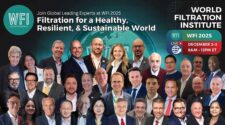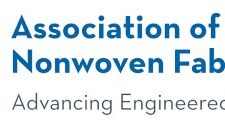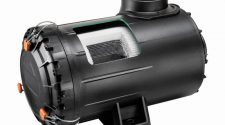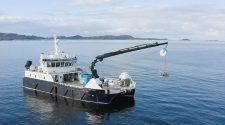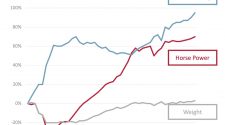Filtrex & FiltXPO 2025 Bring the Best of Filtration on Different Continents
Advancements in nonwoven filter media will take center stage at two major events on both sides of the Atlantic this spring.
EDANA’s two-day FILTREX™ 2025 Conference in Vienna, Austria, March 25-26, followed by INDA’s FiltXPO 2025 Conference & Exhibition on April 29-May 1 at the Miami Beach Convention Center in Florida, held alongside the broader triennial IDEA® 25 show. Over 600 exhibitors are expected at the IDEA/FiltXPO show.
The converging themes of these two conferences reflect a recently-announced closer cooperation between the two leading industry associations – EDANA, based in Brussels, Belgium, and INDA of Cary, North Carolina.
Automotive Focus at FILTREX
A key theme at Filtrex 2025 will be the applications of nonwoven filter media in the automotive industry. Frank Möbius, former head of technology scouting and forecasting at BMW Group, will be the keynote speaker. His presentation, entitled Open Innovation, the Key to Future Success for Your Company, will explore how automotive industry leaders like BMW realize open innovation in their organizations and outline ten essential steps in adopting similar approaches.
A new session announced for the meeting in Vienna will also specifically explore media developments for automotive filtration, bringing together experts from three leaders in this field – Ahlstrom, Freudenberg FT, and Neenah Gessner.
Air Intake
Ahlstrom Italia’s Simone Cerminara will outline the various types of standard air intake media for engines and explore their benefits for filter manufacturers. Among recent Ahlstrom introductions in this area is a range of renewable, lignin-based filter media called Ahlstrom Eco. Lignin, a natural polymer found in plant cell walls, offers structural support while significantly improving the product’s carbon footprint.
Currently used in automotive applications such as engine air intake, oil, and fuel filtration, lignin-based media also reduce formaldehyde emissions during the curing process, making them a more sustainable option. Using a significant amount of bio-based, renewable lignin rather than fossil-based resins, Ahlstrom Eco is said to maintain its mechanical properties and durability even in challenging environments.
This lignin-based impregnated filter media has a lower carbon footprint than standard fossil-based resin media. Additionally, the recipe significantly reduces formaldehyde emissions by 50-70% during the curing process.
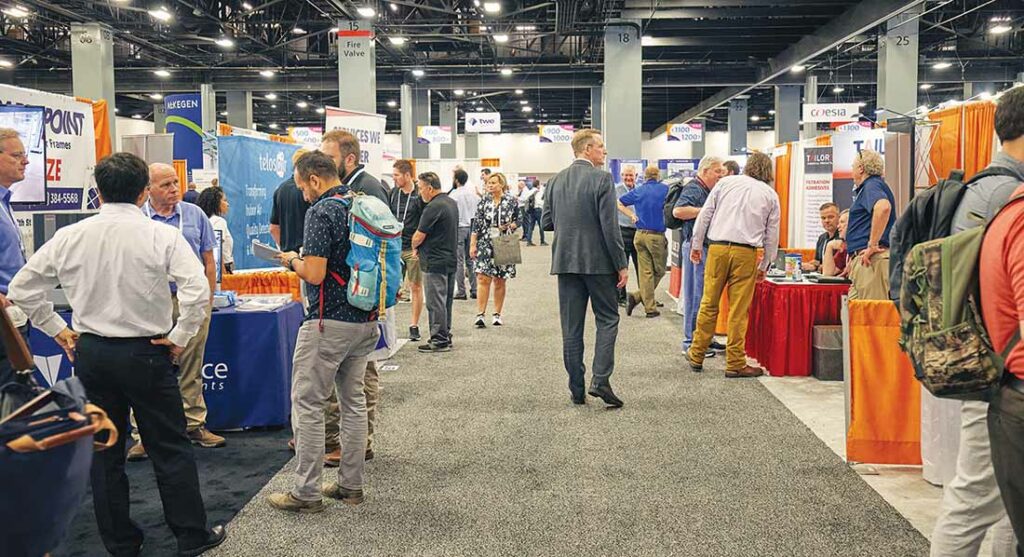
Media Options
Freudenberg FT’s Christian Ewald will further explore the advantages and limitations of new European Union standards such as ISO 10121-3 and Eurovent 4/26 relating to automotive emissions and air quality, how they impact ensuring a safe work environment and superior corrosion protection, and how to select the best cost-performance filtration solution while accurately calculating the most economic filter lifetimes.
The Freudenberg Group as a whole supplies a wide range of technologies aimed at helping engines work reliably, including vibration control technologies, durable bearings, specialty chemicals and surface treatment and galvanization technology, as well as filter media.
PCF
Christof Keppler of Neenah Gessner will then outline the importance of a filter media’s product carbon footprint (PCF) and how lowering it impacts on both performance and cost structure, paving the way for more sustainable filtration solutions.
Like Ahlstrom, Gessner, a Mativ company, is replacing commonly used phenolic resins with lignin-based resins in its wet-laid nonwoven cellulose filter media and is also behind other innovations.
Unlike many nonwovens that incorporate delicate layers of continuous electrospun fibers, for example, MecNa is a filter media with individual nanofibers directly integrated into its structure. Alphastar and NeenahPure nonwovens feature activated carbon layers for pleated media and bag filters. These layers capture and neutralize impurities such as volatile organic compounds (VOCs), odors, and other contaminants.
Healthy Buildings & Nonwoven Innovation at FiltXPO
INDA just announced the FiltXPO 2025 Conference program, developed jointly with the American Filtration and Separations Society (AFS), that explores some key end-use markets for nonwoven filter media, including their applications in buildings and living spaces for guaranteeing cleaner indoor air quality (IAQ), and intriguingly, the increasing significance of this in data centers.
Options for Better Buildings
Healthy Buildings: Transforming IAQ – Strategies, Technologies, and Innovations for Healthy Living Spaces kicks off the educational sessions, moderated by Mark Clark, Division President of Filtations
Solutions, Hollingsworth and Vose Company, and Rahul Bharadwaj, Senior Applications Engineering Manager, Alkegen.
Erlab USA’s Lisa Greenfield, CAFS, Director and Jesse Coiro, Director/General Manager, explores assessing and assuring quality indoor air with strategies. The various dimensions of indoor air pollution and its significant impact on our daily lives, especially for children who are more vulnerable to poor air quality due to their developing respiratory systems. Asthma is a leading cause of school absenteeism in our younger generations. Other groups at risk are the elderly, immunocompromised and people of color. Tools for accurate monitoring, comprehensive filtration systems, and strategic interventions must be employed to improve IAQ, and health and wellness.
Adding to the discussion, Bruce Lorange, Global Marketing Manager, H&V, presents a recent company multi-month case study in Delhi, India, exploring enhanced filtration for human health. “Indoor air quality is the world’s leading environmental health threat, especially in cities, where 70% of the global population will live by 2050,” notes Lorange. The study illustrates with real-world data that effective HVAC filtration does, in fact, greatly improve IAQ.
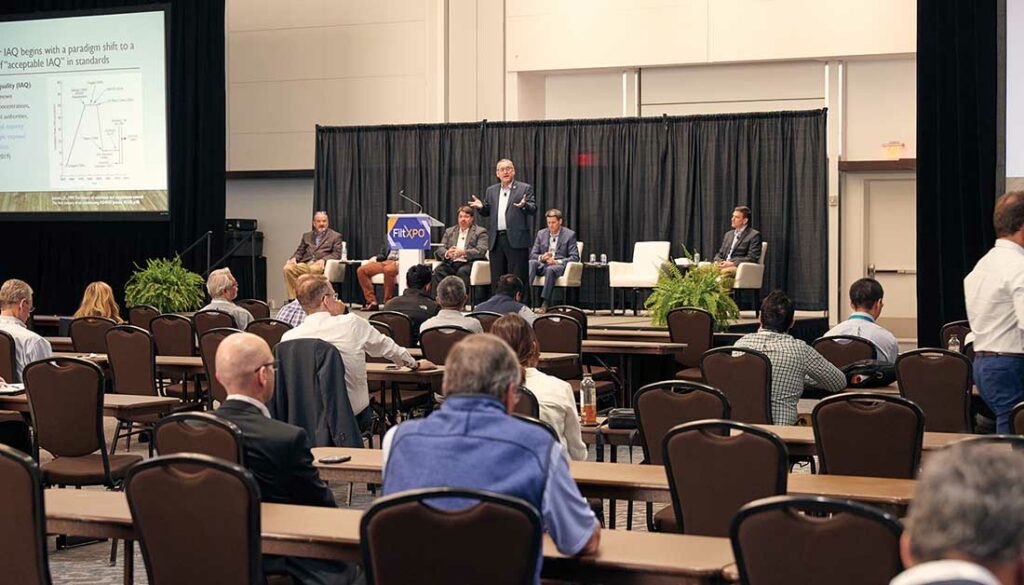
Maria Figols, Chief Scientific Officer, and John Oliver, International Business Development Manager of InBiot Monitoring SL, share their knowledge of real-time indoor air quality monitoring. They share how integrating InBiot’s real-time IAQ data with Building Management Systems (BMS) enhances the control and responsiveness of indoor environments. By feeding precise IAQ metrics directly into BMS, facility managers can automate ventilation, filtration, and HVAC adjustments based on current air quality needs.
Tyler Smith, Vice President, Healthy Buildings, HVAC & Controls, Johnson Controls Inc. says, “Buildings account for 40% of global CO2 emissions, and we spend 90% of our time indoors. As leaders, we have a responsibility to design, construct, and operate buildings in a way that optimizes for the planet’s health AND for the health of occupants.” He emphasizes that smart building technology using artificial intelligence are a necessary component of any sustainability strategy.
Presenting a new topic – Air Quality in Data Centers: People vs. the Machines – Chris Muller of AAF International notes that IAQ is mostly associated with the health, well-being, and comfort of
humans in an occupiable space. However, in mission-critical facilities such as data centers, it is being scrutinized less for the human occupants and more for the “health” of the critical informational technology (IT) and datacom equipment.
“Regulatory changes in place since 2006 resulted in much higher failure rates for IT and datacom equipment in facilities located in regions with high air pollution levels,” he explains. “The use of outdoor air for free cooling as a way to reduce energy costs has reached the mainstream of data center design, and for many companies, it is now a standard design approach for all new facilities. However, as free cooling expands, many locations are experiencing higher equipment failure rates due to gaseous pollutants, higher temperatures, and fluctuating humidity inside the data center.”
As data centers evolve to support increasing computational demands, he adds, the need for effective management has never been more critical.
Following his presentation, an expert panel will explore the intersection of airflow, filtration, and energy efficiency, examining how contamination control impacts equipment reliability and operational sustainability. The challenges posed by rising heat loads, the effects of outdoor air integration, and the industry’s response to regulatory changes will be fully discussed. Participants include moderator Michael Chen, Ph.D., President, Midwest Filtration; Jon deRidder, VP of Innovation, Data Clean; and Christopher Muller.
Innovating Nonwovens
Nonwovens media is the star of the next set of sessions, and innovation is not lacking amongst these presentations. Kimberley Espinosa, VP – Sales & Marketing, CEREX Advanced Fabrics, Inc. and Martin Lehmann, Ph.D., Principal Expert Research Network and Public Funding, Mann + Hummel GmbH each serve as moderators.
American Truetzschler’s Lothar Kaierle, VP Sales Nonwovens, delves into the importance of superior needle-punched nonwovens quality for enhanced fabric uniformity, strength, and overall
performance.
Math2Market’s Andreas Wiegmann, Ph.D., explores how using CT scans for fiber length distribution determination offers a novel, digital, non-destructive method that is more efficient, reproducible, and accurate.
Samia Moore, Global Marketing Management, H&V, shares their recent innovation, filter media that offers a more intuitive and comprehensive design and production solution for P100 respirators without relying on fluorochemistry. NanoWave® ESA is an all-synthetic media, that can achieve P100 efficiency without pleating and with higher user comfort, and is getting positive reviews from RPE producers.
PFAS concerns and increasing regulatory pressures are to be discussed by Ping Hao, Ph.D., Sr. Nonwoven & Filtration Scientist, Superior Felt & Filtration. She addresses innovative filtration technologies that provide PFAS-free solutions, focusing on advanced nanofiber technologies, bio-based polymers, and composite materials engineered for high filtration efficiency and sustainability.
Then Kevin Guo, Ph.D., COO, Matregenix showcases his company’s PFAS-free HEPA and ULPA nanofiber filter technology designed for healthcare, cleanrooms, and industrial manufacturing, among other settings.
Presenters from Ahlstrom – Kent Williamson, Head of Product Development & Quality and Magnera– Saravanan Andan, Principal Engineer Scientist round out this topic.
Williamson shares the two main aspects of sustainability, which include materials sourcing and high-performance design. Andan gets technical on spun-bond web methods to improve the uniformity and consistency. Methods to employ include using different fiber cross-sections, fiber sizes, electrostatics, laydown air handling, throughput, and multiple beams.
Moderator Koen Bastiaens, Principal, will then bring together panelists to discuss sustainable innovations, circularity, advanced materials, and eco-friendly practices, as well as new government regulations, cutting-edge filtration technologies, and the impact of improved filter media on performance and sustainability.
Exposition Miami
Miami Beach, Florida is the backdrop for FiltXPO/IDEA 25 this year. The almost sold-out expo floor features over 600 companies, a Miami-Vice-themed lounge sponsored by Kimberly Clark, and lightning talks on sustainability at the INDA booth. The IDEA 25 Show’s “Sustainability Conference,” will run concurrently with FiltXPO’s educational track.
Awards Program
Rounding out the excitement, winners of the 2025 Filtrex and FiltXpo Innovation Awards, decided upon separately by expert judging panels and delegate votes, will be announced during the conferences, along with significant networking opportunities. Find more details and registration information at www.edana.org/events/filtrex and www.filtxpo.com.



